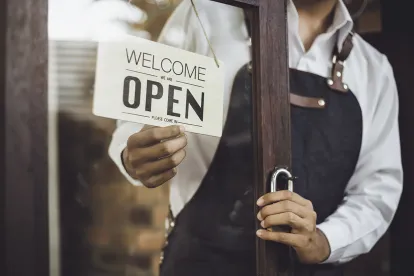Every state in the country is now squarely in the process of going green — reopening all sectors of their economies, with at last count about 20% of the states fully reopened (including those that never closed at all).
The state closures have been estimated to cost the US economy $14 billion per day. While the various reopenings, along with federal aid, are breathing some life into a national economy on its knees, and our map is now trending green, it is not all good news. At last count, almost fifteen states are reportedly seeing sudden spikes in COVID-19 cases (including Arizona, South Carolina, Florida, Alaska, Arkansas, California, Kentucky, New Mexico, North Carolina, Mississippi, Oregon, Tennessee, Texas, Utah and Puerto Rico), creating concerns about a “second wave” of infections. Indeed, Oregon recently announced a one-week “pause” before further reopening after experiencing the highest daily statewide count of cases since the start of the pandemic across both urban and rural areas.
That fear could hamper the economic recovery, despite the reopening of businesses across the country. Christopher M. Meissner, PhD, and Peter Zhixian Lin, economists from the Department of Economics at UC Davis, found that lifting stay-at-home orders may not make much of a difference in terms of economic effects. “If the disease is still out there and people perceive it to be dangerous to go out, they will not go out. Also, the rest of the world is in recession, too, and the ‘re-opening’ will have a much smaller than expected impact,” said Dr. Meissner and Mr. Lin.
This could result in what is called a “W-shaped recession,” with an initial economic rebound followed by a second wave of infections, causing another dramatic set of business closings and recession, followed by another recovery. U-shape, check mark, square root symbol, K, and swoosh shaped recoveries are also all on the table, say economists. In addition to a lack of consensus on the “shape” of the recovery, there is also little consensus on the timing of that recovery, although many analysts believe the US (and many industrialized countries) have hit bottom and are recovering.
There is also little consensus on the “best” approach to reopening the economy, with experts struggling to find the right balance between improving the economy while putting safeguards in place to avoid a spike in new COVID-19 cases – and the stakes couldn’t be higher. One thing that has been evident to us in tracking state reopening orders is that not only has there been a difference in timing among the states, apart from most states taking a phased or staged approach to reopening (rather than flipping the on switch across all sectors of the economy), the approaches states have taken to reopening have varied considerably. One example to think about that could potentially play a role in a state’s ability to deal with localized flare-ups should they emerge, with limited disruption to the economy at large, is the extent to which the state takes a statewide one-size-fits-all approach, or makes reopening decisions on a county-by-county or regional basis, largely managed by local jurisdictions, with varying degrees of state oversight.
On one side, we have states that have taken a top-down approach to their reopening orders, occupying the reopening field so to speak, and barring local jurisdictions from taking a stricter or slower approach to reopening, or taking action within the subject matter of a particular reopening order. So, for example, in mid-May, Arizona’s governor deemed all COVID-related restrictions to have been expired and rescinded, and offered only voluntary guidelines for businesses to consider in reopening. His executive order further prohibited any locality from issuing any order that is in addition to or conflicts with his state wide executive order. Similarly, in Georgia, Governor Kemp suspended any county or municipal ordinance or order that was more or less restrictive than the state’s Order.
On the other side are those states that either require localities or regions to meet certain benchmarks before they can proceed through progressive reopening phases or permit them to opt out of particular statewide reopening altogether, essentially taking a more nuanced or granular approach to the reopening process. So for example, Oregon, Maryland and New York have allowed local orders—including ones that are more restrictive—to be issued and remain in effect alongside state orders. Indiana and Michigan have divided their states into different regions that are permitted to transition to the different phases of re-opening at different times. Nevertheless, Oregon’s latest spike prompted it to override county-based reopening decisions for at least a week.
One question to consider as we’re seeing spikes in cases in a number of states is whether states that have not done so should consider a more granular approach to stay-at-home and reopening decisions. In other words, would it make sense generally for states to have processes in place by which reopenings in particular localities can be dialed back where appropriate based on a particular jurisdiction’s experience and trends? The question is whether doing so would allow states to better address flare-ups where they occur, with less disruption statewide, and less impact on their economies overall.
Still, beyond the varying state approaches to business reopenings, there is the very real human factor that each of us experiences every day. Economists Meissner and Zhixian Lin, mentioned above, believe, at a high level, that any economic rebound from reopening may be hampered by people’s fear of going out, regardless of what state orders may permit, an affect that will no doubt be exacerbated by rebounds in the disease and the reemergence of hot spots. But still, those perceptions vary literally person-by-person, as we all see and experience in our daily travels.
In large and small cities around the country, the stark contrast between those who are going to restaurants and gathering in large groups, both masked and unmasked, and those who are wearing masks even while driving their cars, exemplifies the fact that there is confusion and little consensus on the “best” approach to staying safe as the economy reopens. This divide is perhaps exacerbated by the fact that we are all getting our information from an abundance of sources, with no clear consensus on required steps to keep one’s self safe when venturing out (or for that matter, when ordering in). The World Health Organization has coined this an “infodemic” — the massive amounts of both accurate and inaccurate information swirling around about the pandemic.
Indeed, somewhat ironically, the WHO itself contributed to that very infodemic early this week, with statements from its Coronavirus technical lead that transmission by asymptomatic people is rare, statements which were then quickly walked back. The point is that all of us are faced with continuing confusion about the “safe” thing to do to protect ourselves and those members of the community who are at a heightened risk of contracting and becoming ill from the virus, with no consensus, no accepted norms, and significant variability throughout the population on COVID-related behaviors.
So what’s the point? As we watched our map turn to shades of green across the country, and watched as maps like this one show various states seeing spikes in COVID-19 infections, combined with a wildly fluctuating U.S. stock market, we are left with the realization that there is little predictability in the economics or epidemiology of COVID-19.
With all that in mind, we leave you with a final thought as to Why the Coronavirus Is So Confusing:
“In the classic hero’s journey—the archetypal plot structure of myths and movies—the protagonist reluctantly departs from normal life, enters the unknown, endures successive trials, and eventually returns home, having been transformed. If such a character exists in the coronavirus story, it is not an individual, but the entire modern world. The end of its journey and the nature of its final transformation will arise from our collective imagination and action. And they, like so much else about this moment, are still uncertain.”








 />i
/>i


